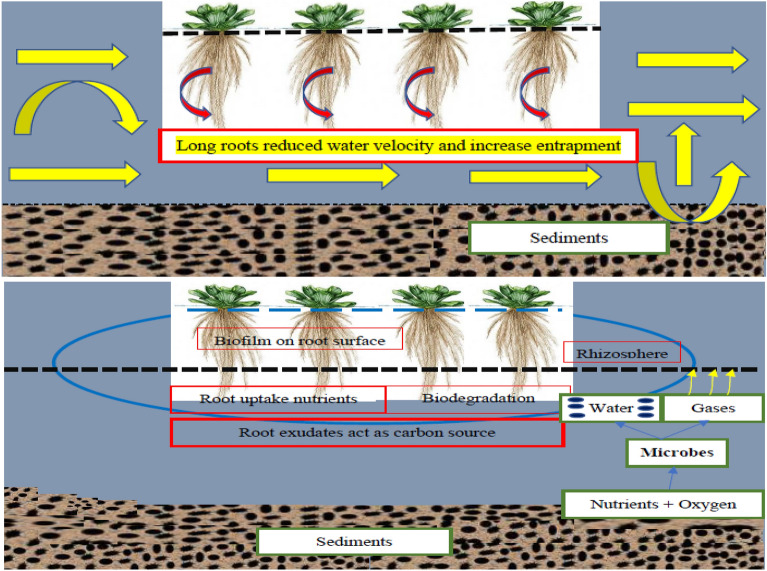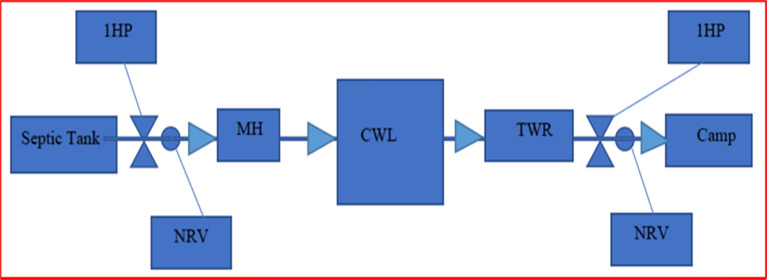Abstract
The objective of the study was to evaluate the performance of Pistia stratiotes for treatment of domestic wastewater in a free surface water flow constructed wetland. The objective of the study was to evaluate contaminants removal efficiency of the constructed wetland vegetated with P. stratiotes in treatment of domestic wastewater against Hydraulic retention time (HRT) of 10, 20 and 30 days was investigated. This asks for newer and efficient low-cost nature-based water treatment system which along with cost takes into consideration the sustainability of the ecosystem. Five constructed wetland setups improved the wastewater quality and purify it significantly by reducing the TDS by 83%, TSS by 82%, BOD by 82%, COD by 81%, Chloride by 80%, Sulfate by 77%, NH3 by 84% and Total Oil and Grease by 74%. There was an increase in pH of about 11.9%. Color and odor of wastewater was also improved significantly and effectively. It was observed that 30 days’ HRT was optimum for the treatment of domestic wastewater. The final effluent was found to be suitable as per national environmental quality standards and recycled for watering plants and crop irrigation but not for drinking purposes. The treatment in constructed wetland system was found to be economical, as the cost of construction only was involved and operational and maintenance cost very minimal. Even this research was conducted on the sole purpose of commuting the efficiency of pollutant removal in short span time.
Keywords: Pistia stratiotes, Constructed wetland, Domestic wastewater treatment, Macrophytes, Removal efficiency, Hydraulic retention time
Subject terms: Plant sciences, Environmental sciences, Hydrology
Introduction
For many years, a large amount of untreated effluent was dispensed into streams, rivers, lakes, coastal areas and seasonal tributaries. Population growth, anthropogenic activities land, expansion of numerous industries and climatic changes are the main reasons behind the decline and contamination of the aquatic environment1,2. When untreated water is directly released into the natural water bodies, it not only destroys the aquatic systems but also spoils the condition of water resources by a large amount. Increased amount of contaminants in the wastewater is extremely dangerous for the existence of aquatic ecosystem and it further increases threats on health of human beings3–5. Topical researchers have declared that phytoremediation by aquatic plants have a great potential to eradicate numerous organic and inorganic pollutants from wastewater6–12. Application of free-floating aquatic plants for wastewater treatment in the constructed wetlands is a natural, low cost and environment-friendly method for wastewater management13–16. Plant roots play a key role in floating treatment wetland (FTW), by providing a living, yet high specific surface area for the development of biofilms that contain diverse micro-organism communities responsible for filtering and entrapping fine suspended particles17,18. Constructed Wetlands are artificially engineered treatment systems that utilize natural cycles or processes involving soils, wetland vegetation, and plant and soil-associated microbial assemblages to remediate contaminated water and improve its quality. Herein, we present a detailed assessment of contaminant removal effectiveness in different CW systems, i.e., free-water surface or surface-flow constructed wetlands (FWSCWs/SFCWs), subsurface-flow constructed wetlands (SSFCWs), and hybrid constructed wetlands (HCWs)19. Constructed wetlands are designed and built to replica the processes happening in natural wetlands. In this current era, constructed wetlands are broadly used and applied across the world in order to treat wastewater from all sectors for the purpose of wastewater management20,21.
Pakistan is an agricultural country and most of the economy depends on water for growing crops. It is the third most affected country in terms of water scarcity as per International Monetary Fund22. Presently, only 20% population of the country has access to clean drinking water. The rest 80% population has no availability to clean water and has to depend on polluted and contaminated water from different sources such as sewage, industrial effluents, pesticides and fertilizers etc.23,24. Therefore, in view of wastewater management and water sustainability, it is the only option left that water is recovered and recycled to meet the future water shortage challenges. The effluent from the wet land was found useful in irrigation and keeping aquatic animals. However, it was noted that a 30- day detention time was found optimized for the treatment kitchen waste water25.
In major cities, domestic and industrial effluents are discharged into natural tributaries, streams, lakes, canals, and rivers, being the instantaneous discharging vicinity close to the cities resulting high pollution load in the water bodies. Pakistan is a developing country and cannot afford expensive conventional technologies to treat wastewater. It has a suitable climate and land availability for wastewater treatment by applying constructed wetlands in the peripheries of cities and towns, as it can provide a cost-effective, long lasting and aesthetic solution to wastewater remediation. CW have the potential to offset energy and irrigation needs at scales ranging from small communities to peri-urban areas. Constructed wetlands used to treat wastewater have the potential to provide a sustainable bioenergy source without placing burdens on water resources or displacing other food or energy crops26.
Pistia stratiotes is a kind of free-floating aquatic macrophytes which is broadly applied for the elimination of containments from the wastewater prior to discharge in order to decrease the pollution loads on natural water bodies. The biomass of the P. stratiotes increases rapidly. It is reported that in just 5, 10 and 20 days its mass becomes double, triple, and quadruple respectively. In a period of less than 1 month its biomass will increase by nine times as compared to its original biomass. It possesses long hanging root-biofilm network as biologically active surface area for biochemical and physical processes such as filtering and entrapment. These submerged long roots capitalize on the contact between the root-biofilm network and the contaminated and polluted water passing through the constructed wetlands. The reason for choosing P. stratiotes is its high pollutant removal efficiency and it can also remove organic and inorganic pollutants including heavy metals from the industrial, domestic, municipal, agricultural sewage sludge, and drainage ditches16,27. Despite its notorious reputation as an alien plants, water lettuce has also been widely applied in wastewater phytoremediation in tropical areas28 because of its prolific growth characteristics29, great potential in nitrogen and phosphorous removal30, significant absorption, and enrichment in several heavy metals31.
A larger quantity of P. stratiotes plants translates to a higher total surface area of roots and leaves available for nutrient and pollutant absorption. The increased surface area provides more opportunities for the plant to interact with and uptake contaminants from the water. Further, raw water first stored in septic tanks from where water is pumped into constructed wetlands (CWs) by pumping unit. So, treatment of raw water also took place in septic tanks to some extents. The objective of the present study was to evaluate the removal efficiency of a constructed wetland using P. stratiotes in the treatment of domestic wastewater. Therefore, a free water surface flow constructed wetland was built by a multinational oil and gas organization in its facility near Gumbt, district Kohat, Khyber Pakhtukhwa, Pakistan to treat domestic wastewater. The research is significant for improving the overall efficiency of constructed wetlands by harnessing the pollutant removal capabilities of P. stratiotes. This can contribute to more sustainable and environmentally friendly wastewater treatment practices. Various physico chemical parameters such as biochemical oxygen demand (BOD5), chemical oxygen demand (COD), total dissolved solids (TDS), total suspended solids (TSS), sulfate, chloride, ammonia, color and pH were analyzed in the laboratory in order to check the quality of water after phytoremediation. The research contributes to the scientific understanding of the interactions between P. stratiotes and pollutants in constructed wetlands. It adds valuable knowledge to the field of phytoremediation and sustainable water management practices.
Results and discussion
Sedimentation, filtration, deposition, adsorption, and microbial mediated reactions and Pistia stratiotes uptake, transport, and biological assimilation are the processes involved in the removal of pollutants. Pistia stratiotes has a hanging network of long roots, rhizomes and attached biofilm on the root surfaces. This hanging root-biofilm network of Pistia stratiotes provides a biologically active surface area for biochemical and physical processes such as filtering and entrapment. These submerged long roots capitalize on the contact between the root-biofilm network and the contaminated and polluted water32,33. These roots also reduce the water velocity which ultimately enhances the microbial activities, sedimentation, plant uptake, transport and biological assimilation rates, thus enhancing pollutant removal efficiency (Fig. 1).
Figure 1.
Pistia stratiotes hanging root system and purification mechanism in constructed wetland.
In Fig. 1, the plant floats on the water surface, and its roots dangle beneath, submerged in the water column. These roots are feathery and have a high surface area, facilitating efficient nutrient and pollutant absorption. The characteristics of this root system and its interactions with pollutants is essential for optimizing the performance of constructed wetlands for wastewater treatment. Figure 2 (Table 1) is showing the reduced percentage of containments against HRT.
Figure 2.
Containments % reduction against HRT.
Table 1.
Containments (%) reduction against HRT.
| Parameters | Day 10 | Day 20 | Day 30 |
|---|---|---|---|
| pH | 2.9 | 6.7 | 11.9 |
| TDS | 33 | 62 | 83 |
| TSS | 41 | 64 | 82 |
| Chloride | 38 | 62 | 80 |
| Sulphate | 33 | 70 | 77 |
| Total oil and grease | 49 | 66 | 74 |
| BOD5 | 33 | 63 | 82 |
| COD | 33 | 63 | 81 |
| Ammonia | 35 | 67 | 84 |
Biological oxygen demand and chemical oxygen demand
The result of the analysis has shown progressive and consistent reductions of BOD and COD levels in wastewater. There was 82% of BOD and 81% of COD reduction on 30 days which is the maximum as per the record (Figs. 3, 4). Rise in pH (Fig. 11) has also confirmed their removal in the constructed wetland vegetated with P. stratiotes. Chandanshive et al.34 have already proved in a research study that pH of the wastewater can be increased by applying free floating aquatic macrophytes by reducing BOD and COD in wastewater. The removal of chemical oxygen demand by A. filiculoides (96%) was slightly higher than the L. minor (92%), but the biochemical oxygen demand removal by L. minor (92%) was significantly higher than A. filiculoides (90%). Despite the high removals of chemical and biochemical oxygen demands, total phosphorus and total nitrogen attained, the concentrations were found exceeding the discharge and agricultural reuse limits35. Similar results have also been investigated and reported that higher COD and BOD levels can be degraded by using different free-floating aquatic macrophytes to treat different wastewaters36,37. Free floating aquatic plants support the development of microorganisms and their activities which provides the foundations for decomposing organic matters38–40. The only demerit of P. stratiotes is that it does not grow at higher COD levels41.
Figure 3.
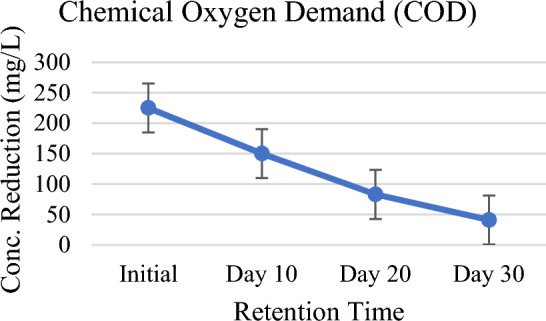
Chemical oxygen demand (COD) against HRT.
Figure 4.

Biological oxygen demand (BOD5) against HRT.
Figure 11.
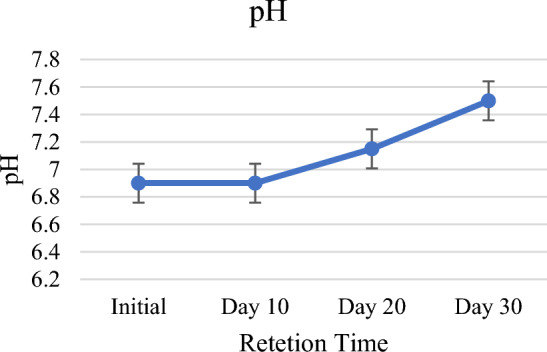
Graph of pH against HRT.
Total suspended solids and total dissolved solids
Reduction trend in the levels of TSS and TDS has been continuously observed in the setup against the HRT. The results showed TSS and TDS levels as 850 mg/L and 1200 mg/L for raw water but for the HRT levels are 500 mg/L (reduced by 41%), 305 mg/L (reduced by 64%), 150 mg/L (reduced by 82%), 800 mg/L (reduced by 33%), 455 mg/L (reduced by 62%) and 200 mg/L (reduced by 83%) respectively (Figs. 5, 6). Insistent reduction was because of the sedimentation, filtration, deposition, adsorption, and microbial activities in the constructed wetland. The rate of microbial activities was highest in the pond 5 where large number of P. stratiotes were planted. Da Silva et al.42 and Osti et al.43 have already proved in a study that TSS and TDS reduction by P. stratiotes is higher than all other free-floating aquatic macrophytes. Pistia stratiotes and Chrysopogon zizanioides for the removal of Total dissolved solids (TDS) from second stage RO brine solution of textile dying industry by attached growth shallow pond system. Under 10 days of operational period, water hyacinth (W.H) showed maximum removal of 55.6% of TDS on 6th day, 48.7% in case of water lettuce (W.L) on 7th day and 39.6% TDS removal on 3rd under Vetiver (V.V) treatment system44. Treatment system also reduced total dissolved solids (TDS) around 35.2% by combined effect of wetland plants namely L. minor, T. latifolia, and S. acutuson. Sequential phytoremediation with a mixture of plants was more effective than that relying only on a single plant species45. In addition Lu et al.30 observed that total suspended particles in the water column were reduced by around 10% in treatment plots as compared to control plots.
Figure 5.
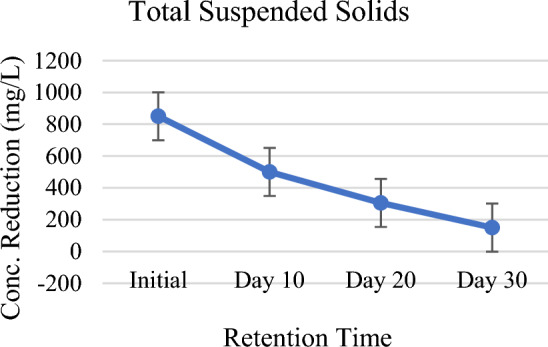
Total suspended solid against HRT.
Figure 6.
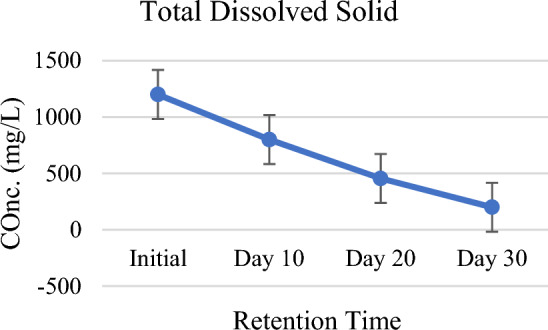
Total dissolved solid against HRT.
Ammonia
Both ammonia (NH3) as well as ionized ammonia (NH4+) exist in water in a soluble form in a state of equilibrium. Ammonium is a vital nutrient needed for free-floating aquatic macrophytes growth like Pistia stratiotes. Fresh sewage has around 25% nitrogen in organic form. Environmental impacts of ammoniacal nitrogen in wastewater are acidifications, aquatic ecosystems variations, and eutrophication of surface water46. Therefore, it is very necessary to treat the excess ammonia in the wastewater prior to discharge into the aquatic environment. The nitrogen in the form of organic is almost converted to NH3-N, and further converted to nitrate with the aid of microbial oxidation. Pistia stratiotes is reported to reduce the ammonium ions from the water as it utilizes NH4–N prior to NO3–N as nitrogen source and does not switch on the utilization of NO3–N until NH4–N gets consumed entirely47. Shah et al.48 has also reported a similar investigation in an experimental study. The results confirmed that P. stratiotes remarkably reduced ammonia from initial levels of 8.4 mg/L to final 1.35 mg/L (Table 2, Fig. 7). P. stratiotes absorb the nutrients through roots and transport them to other parts of the plant for various cellular functions. The uptake, transportation, and assimilation in different body parts are the steps involved for ammoniacal nitrogen utilization in macrophytes49,50. Aquatic macrophytes use ammoniacal nitrogen for plant growth51. In addition to plant uptake, removal of N also occurred by volatilization of NH3 with increasing pH in the water. Ammonia removal can also occur by nitrification and denitrification under aerobic and anaerobic conditions. Shah et al.48 investigated in a study that higher values of pH in wastewater favor the volatilization of NH3. Kutty et al.52 reported the ability of water hyacinth for removing ammonia, phosphorus and nitrate from the municipal wastewater treatment plant effluent. Constructed wetlands are almost completely conversed with emerging macrophytes and are being managed as water quality improving systems, some commonly used macrophytes.
Table 2.
Containments reduction against HRT.
| Parameters | Initial | Day 10 | Day 20 | Day 30 | Units |
|---|---|---|---|---|---|
| pH | 6.9 | 6.9 | 7.15 | 7.5 | – |
| TDS | 1200 | 800 | 455 | 200 | mg/L |
| TSS | 850 | 500 | 305 | 150 | mg/L |
| Chloride | 200 | 155 | 95 | 50 | mg/L |
| Sulphate | 1000 | 667 | 300 | 227 | mg/L |
| Total oil and grease | 98 | 50 | 33 | 25 | mg/L |
| BOD5 | 195 | 130 | 72 | 36 | mg/L |
| COD | 225 | 150 | 83 | 41 | mg/L |
| Ammonia | 8.4 | 5.5 | 2.8 | 1.35 | mg/L |
Figure 7.

Graph of ammonia against HRT.
Sulfate and chloride
As shown in Table 2 and Fig. 8, at the end of retention period that the system effectively and consistently removed 33%, 70% and 77% of Sulfate (SO42−). In the setup, vegetated P. stratiotes provided an appropriate roots zone for biological assimilation and the sulfate precipitation process. Redox state dynamics at the roots zone of P. stratiotes together with organic carbon and O2 is responsible for the fate of sulfate in the wastewater53. Microbes especially sulfate-reducing bacteria, play vital role in the reduction of sulfate in the presence of oxygen54. Moreover, SO42− loses due to oxidation of sulfide (S2−) to SO42−, and by dissociation reactions in which S2− is converted into hydrogen sulfide. Hydrogen sulfide is chiefly volatile to atmosphere55. At the initial stage, rise of pH indicate that hydrogen sulfide has emitted to the atmosphere. Formation of insoluble metal sulfates (like FeSO4, ZnSO4) and mineral sulfates (such as CaSO4) caused by heavy metal precipitation are other sources of sulfate losses. This happens when SO4−2 is more auspicious than S−2 in wastewater56. Macrophytes and microbe’s uptake organic S for their biomass3, O2 released by the plants via roots zone utilized for direct re-oxidation of S−2 to SO4−2, stimulate microorganism growth and activity57. Thus, it can be concluded that uptake by P. stratiotes, sulfate precipitation, reduction–oxidation of S−2 in the system were the processes involved in the removal of SO4−2. In case of chloride reduction in chloride observed was 80% at the 30-day of HRT (Fig. 9). Chloride is required in minor amounts and it helps in processes such as growth, photosynthesis, metabolism, photosynthesis, osmosis, and ionic balance within the cells of Pistia stratiotes. High reduction of chloride might happened be due to its minute concentration in wastewater51.
Figure 8.
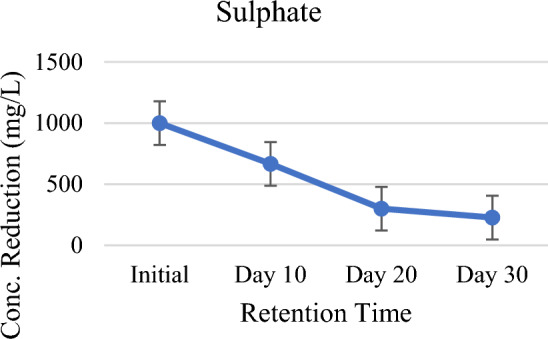
Graph of sulfate against HRT.
Figure 9.
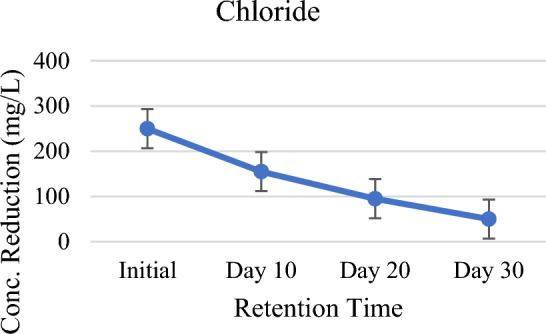
Chloride against HRT.
Total oil and grease
The result obtained shows a consistent pattern for the removal of total oil and grease from the wastewater in the constructed wetland planted with P. stratiotes. The initial value of oil and grease in wastewater is 98 mg/L which has reduced to 50 mg/L (49% reduction), 33 mg/L (66% reduction), and 25 mg/L (74% reduction) in the system for the HRT of 10, 20 and 30 days (Table 2, Figs. 2, 10). It has already been reported that degradation of oil and grease by macrophytes is attributed to the enhancement of microbial growth resulting in reduction of oil and grease58,59.
Figure 10.
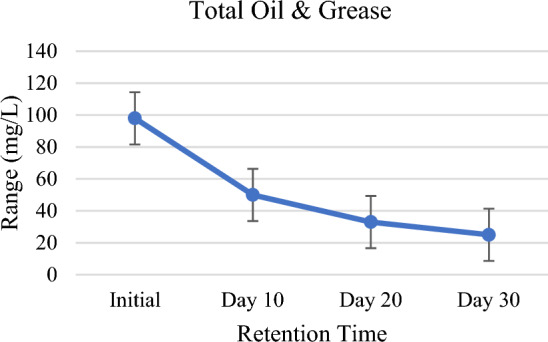
Total oil and grease against HRT.
Odor
Odor of domestic wastewater was offensive due to variation of organic and inorganic pollutants, which lower atmospheric ambient air quality and is a health hazard for nearby community. Pistia stratiotes in the system, progressively and effectively reduced the offensive odor to odorless in the HRT of 10, 20 and 30 days by incessant effective eradication of organic and inorganic pollutants in the wastewater. Oladejo et al.60 has already confirmed that Pistia stratiotes has the capability to change offensive odor of wastewater to odorless.
Color
One of the most important parameters present in domestic wastewater is color. It is caused by variations in contaminants and their mutual reactions in wastewater. P. stratiotes has changed the color of wastewater from grey black to colorless. The significant improvement in the color of wastewater indicated a significant elimination of various pollutants from the wastewater by P. stratiotes. The color elimination capability of P. stratiotes might be attributed to the appropriate particle sedimentation capability of P. stratiotes or the capacity of the root of P. stratiotes to hold together coarse and fine particles61.
pH
The pH of raw water was slightly acidic, the results obtained have shown that P. stratiotes in the setup has improved the pH of the wastewater from 6.7 to 7.5 (Table 2, Fig. 11). The highest increased pH 11.9% was observed on 30-day (Table 2, Fig. 2). The pH of the domestic wastewater was improved from slightly acidic to slightly basic. This rise in pH might occurred be due to the consumption of carbon dioxide by the plants during the process of photosynthesis. Irawati et al.62 has already reported that an increase in pH might be accredited to the consumption of CO2 during the process of photosynthesis by macrophytes. Similar results regarding the rise in pH have been reported by Galal et al.63, Polechońska et al.64 and Zhao et al.65 in their research studies carried out on free floating aquatic macrophytes for different wastewater streams. Also, the growth of water lettuce resulted to a fall in the pH of the water, even though it was not expected because usually, plant photosynthesis raises the pH of water66. According to Raju et al.67, the maximum increase in biomass production occurred at neutral and slightly alkaline pH (pH 7 and 8), which may be due to the increase in nutrient uptake and immobilization capacity of the water hyacinth samples. The pH of influent water ranged from pH 7.0 to 8.7, and the suitable pH controlled the nutrient absorption and biochemical reactions that took place in living organisms68.
Materials and methods
Study area
A free water surface flow constructed wetland was built by an oil and gas exploration and production multinational organization at its facility to treat domestic wastewater as per National Environmental Quality Standards (NEQS) near town Seni Gumbat, located in Kohat District of Khyber Pakhtunkhwa, Pakistan which lies between latitude 33.5110544° N and longitude 71.709795° E. The terrain consists of mountain ranges, undulating sub montane areas, and plains surrounded by hills. In the north, the mountain ranges generally run north–south; south of the Kābul River, which bisects the province from east to west, the ranges generally run east–west. Kohat valley has a hot semi-arid climate. The district’s yearly temperature and precipitation is 19.15 °C and 128.57 mm respectively.
Constructed wetland setup
Mechanical excavation was carried out to dig a basin of 2.7 m deep. The first layer at the basin is of 2.43 m stone soling followed by 17 cm plain cement concrete (PCC) and high-density polyethylene liner was spread over PCC layer to avoid leaching and infiltration of wastewater down the soil in order to avoid contamination of underground water in case of seepage and leakage. The basin has been divided into six sections by 2.1 m high and 2.7 m wide brick walls namely sedimentation pond with dimension 9.4 m × 6.7 m × 2.1 m and five ponds each with dimension 7 m × 6.7 m × 2.1 m interconnected with three holes each of 2.43 m size in the brick walls to provide maximum HRT for wastewater in each section.
Screening unit is applied at each primary wastewater generation entity like kitchens, messes, showers, wash basins, toilets, laundries, and vehicle wash station to avoid wastewater free from any dirt, debris and littering of all kinds as low as reasonably practicable especially non-biodegradable materials. The wastewater is collected in the septic tank for settling of sludge, heavy particles, decomposition, and reduction of organic matter by anaerobic bacteria and is pumped by a suction pump of I horsepower (HP) fitted with NRV (no return valve) into the manhole close to the constructed wetland at the rate of 2.5 m3/h. The wastewater from the manhole flows in the sedimentation pond provided with filter bed consists of a layer of 0.6 m boulders, 0.6 m overcooked bricks and 0.6 m sand throughout its bed. The size of boulders is 15 cm to 20 cm, 10 cm to 15 cm of overcooked bricks. Overcooked bricks can be utilized as a feasible alternative to natural pebbles. Filter bed with dimension 8.8 m × 6.7 m × 2.1 m increases efficiency for trapping the suspended particles in the wastewater and also acts as substrate for physical, chemical, biological processes and microbial activities to remove pollutants. Turbidity removal efficiency increased with the increment of influent turbidity when bricks were used as the filter media. Valves are control points to control water flow on need basis as a safety back up. Results were not calculated from basin to basin but finally from treated water reservoir (last basin separately constructed not part of CWs. This section is further divided into four parts separated by 2.1 m high and 2.7 m wide brick walls, each wall has three 20 cm holes for flow of wastewater from one section to another so as to enhance the HRT within the sections. The purpose of inserting walls is to increase HRT. Numerous P. stratiotes are planted in these sections to upsurge microbial activities against the suspended particles settled in sections and trapped in filter bed. Water from the sedimentation pond flows in pond 1, 2, 3, 4 and 5 being interconnected and planted with a large number of P. stratiotes. In these ponds, Phytoremediation process would be at utmost stage with free floating aquatic plants. Water treated from these ponds finally flows into the treated water reservoir, a separate constructed tank connected with pond 5 by Poly Vinyl Chloride pipe. Treated water at this stage usually displays quality parameters according to NEQS. It flows by gravity or it can be pumped with 1HP suction pump fitted with NRV (no return valve) into the distribution network (thirty-eight distribution units fitted with valves) installed in the facility at different locations for watering plants, orchards, grass ground of the facility. The schematic flow of wastewater and various sections of setup are shown in (Figs. 12, 13, 14).
Figure 12.

P. stratiotes growth in the wetlands.
Figure 13.
Schematic flow of wastewater in the constructed wetlands.
Figure 14.
(a) Design of constructed wetland experimental setup. (b) Drawing shows the dimensions of all wetlands.
Selection of species of macrophytes
P. stratiotes were selected for the study keeping in view the accessibility of plants as well as the environmental conditions of the area. Plants were provided by Nano Bio-Solution (Pvt), limited Islamabad (Wastewater treatment services provider). At least hundred plants were inserted in each pond and in filtration bed as well. Plant size was 4inch which increased in size in days due to absorption of nutrients from domestic waste water.
Sample collection and analytical procedures
50 mL of small samples were collected at regular intervals, combine them, and mix thoroughly to create a composite sample. Samples were collected only one time after the retention time (HRT) of 10 days, 20 days, and 30 days. The constructed wetland took one month for filling after retaining water for long run. The physico-chemical parameters were measured in situ by using a multi-probe digital meter, BOD/COD meters and atomic absorption. The quantitative analysis of the collected samples was carried out according to APHA (2017) to determine the effect of HRT on the wastewater quality. The parameters tested for are: Colour, odour, pH, Temperature, TDS, TSS, Biochemical Oxygen Demand (BOD5), Chemical oxygen demand (COD), Chloride (Cl−) and Sulfate (SO4), total O&G (TOG) and Ammonia.
Characteristics of raw wastewater and treated water are summarized in Table 3.
Table 3.
Physicochemical analysis of wastewater during HRT.
| Parameters | Initial levels | HRT (days) | Units | ||
|---|---|---|---|---|---|
| 10 | 20 | 30 | |||
| Color | Grey Black | – | – | Colorless | NA |
| Odor | Offensive | – | – | Odorless | NA |
| pH* | 6.7 | 6.9 | 7.15 | 7.5 | – |
| TDS | 1200 | 800 | 455 | 200 | mg/L |
| TSS | 850 | 500 | 305 | 150 | mg/L |
| Chloride | 200 | 155 | 95 | 50 | mg/L |
| Sulfate | 1000 | 667 | 300 | 227 | mg/L |
| Total O&G | 98 | 50 | 33 | 25 | mg/L |
| BOD | 195 | 130 | 72 | 36 | mg/L |
| COD | 225 | 150 | 83 | 41 | mg/L |
| Ammonia | 8.4 | 5.5 | 2.8 | 1.35 | mg/L |
*Value increased.
Statistical analysis was used to process the data, such as mean, standard error, removal efficiencies, linear correlation, and analysis of variance (One-way ANOVA) was done, to analyze efficiency of constructed wetland to treat the wastewater (Table 4). The P-value was 0.000454 and F crit was 2.305 within the group when considered it as source of variance.
Table 4.
Statistical analysis of the data (sum, average, variance).
| Groups | Count | Sum | Average | Variance |
|---|---|---|---|---|
| pH | 4 | 28.45 | 7.1125 | 0.080625 |
| TDS | 4 | 2655 | 663.75 | 188,256.3 |
| TSS | 4 | 1805 | 451.25 | 91,172.92 |
| Chloride | 4 | 550 | 137.5 | 7475 |
| Sulphate | 4 | 2194 | 548.5 | 127,669.7 |
| Total oil and grease (TOG) | 4 | 206 | 51.5 | 1069.667 |
| BOD5 | 4 | 433 | 108.25 | 4844.25 |
| COD | 4 | 499 | 124.75 | 6481.583 |
| Ammonia | 4 | 18.05 | 4.5125 | 9.673958 |
Statement on guidelines
All experimental studies and experimental materials involved in this research are in full compliance with relevant institutional, national and international guidelines and legislation.
Conclusion
The results of the study have revealed that removal efficiency of P. stratiotes based constructed wetland was found to be 83% for TDS, 82% for TSS, 82% for BOD, 81% for COD, 80% for Chloride, 77% for sulfate, 84% for NH3 and 74% for total oil and grease respectively. Sedimentation, filtration, deposition, adsorption, and microbial mediated reactions, formation of solid compounds, and P. stratiotes uptake were contaminants removal mechanisms in the system. The constructed wetland vegetated with P. stratiotes, if appropriately managed, are helpful in dropping the level of organic and inorganic constituents of waste water, before being discharged into drainage system to prevent effects on aquatic flora and fauna. It also minimizes the risk of underground water contamination. Furthermore, it is need of hour that constructed wetland system vegetated by macrophytes should be used for treatment of wastewater being eco-friendly and to have a low O&M cost. The use of P. stratiotes and the edible plant L. sativa could be a potential option to treat domestic wastewater due to relatively high nutrient and organic matter removal efficiency. It is recommended to acclimatize plant for some time after being moved from its original location. For maintenance purposes, the leaves of the plant should be collected regularly to ensure active plants shoot system which enhance proper metabolic activities and nutrient absorption.
Acknowledgements
The authors extend their appreciation to the researchers supporting project number (RSP2024R173), King Saud University, Riyadh, Saudi Arabia.
Author contributions
Conceptualization, M.A., A.A., A.Q., and S.J.; Methodology, N.N., and N.H.; Review and editing, A.H., B.A., R.I., T.C., M.S.E, M.S.A. and M.A; Formal analysis, R.I; Data curation, M.S.E., M.S.A. and M.A., Resources, A.H., B.A., R.I., T.C., M.S.E and M.A. All authors have read and agreed to the published version of the manuscript.
Funding
Open access funding provided by Hungarian University of Agriculture and Life Sciences. Researchers Supporting Project Number (RSP2024R173), King Saud University, Riyadh, Saudi Arabia.
Data availability
The datasets analysed during this study are included in this manuscript.
Competing interests
The authors declare no competing interests.
Footnotes
Publisher's note
Springer Nature remains neutral with regard to jurisdictional claims in published maps and institutional affiliations.
Contributor Information
Ambreen Aslam, Email: ambreenaslam86@hotmail.com.
Afzal Hussain, Email: afzaalh345@gmail.com.
Rashid Iqbal, Email: rashid.iqbal@iub.edu.pk.
Talha Chaudhary, Email: Chaudhary.Talha@stud.uni-mate.hu.
References
- 1.Kumwimba MN, Zhu B, Muyembe DK, Dzakpasu M. Growth characteristics and nutrient removal capability of eco-ditch plants in mesocosm sediment receiving primary domestic wastewater. Environ. Sci. Pollut. Res. 2017;24(30):23926–23938. doi: 10.1007/s11356-017-9992-3. [DOI] [PubMed] [Google Scholar]
- 2.Gonçalves AL, Pires JC, Simões M. A review on the use of microalgal consortia for wastewater treatment. Algal Res. 2017;24:403–415. doi: 10.1016/j.algal.2016.11.008. [DOI] [Google Scholar]
- 3.Ahmed MB, Zhou JL, Ngo HH, Guo W, Thomaidis NS, Xu J. Progress in the biological and chemical treatment technologies for emerging contaminant removal from wastewater: A critical review. J. Hazard. Mater. 2017;323:274–298. doi: 10.1016/j.jhazmat.2016.04.045. [DOI] [PubMed] [Google Scholar]
- 4.Basiglini E, Pintore M, Forni C. Effects of treated industrial wastewaters and temperatures on growth and enzymatic activities of duckweed (Lemna minor L.) Ecotoxicol. Environ. Saf. 2018;153:54–59. doi: 10.1016/j.ecoenv.2018.01.053. [DOI] [PubMed] [Google Scholar]
- 5.Carstea EM, Bridgeman J, Baker A, Reynolds DM. Fluorescence spectroscopy for wastewater monitoring: A review. Water Res. 2016;95:205–219. doi: 10.1016/j.watres.2016.03.021. [DOI] [PubMed] [Google Scholar]
- 6.Ekperusi AO, Sikoki FD, Nwachukwu EO. Application of common duckweed (Lemna minor) in phytoremediation of chemicals in the environment: State and future perspective. Chemosphere. 2019;223:285–309. doi: 10.1016/j.chemosphere.2019.02.025. [DOI] [PubMed] [Google Scholar]
- 7.Yadav R, Singh G, Santal AR, Singh NP. Omics approaches in effective selection and generation of potential plants for phytoremediation of heavy metal from contaminated resources. J. Environ. Manag. 2023;336:117730. doi: 10.1016/j.jenvman.2023.117730. [DOI] [PubMed] [Google Scholar]
- 8.Akinbile CO, et al. Phytoremediation of domestic wastewaters in free water surface constructed wetlands using Azolla pinnata. Int. J. Phytoremediat. 2016;18(1):54–61. doi: 10.1080/15226514.2015.1058330. [DOI] [PubMed] [Google Scholar]
- 9.Al-Baldawi IA. Removal of 1, 2-dichloroethane from real industrial wastewater using a sub-surface batch system with Typha angustifolia L. Ecotoxicol. Environ. Saf. 2018;147:260–265. doi: 10.1016/j.ecoenv.2017.08.022. [DOI] [PubMed] [Google Scholar]
- 10.Sultana N, Alam AKMR, Hoque S. Some physical and chemical characteristics of soil in selected wetlands at Savar, Bangladesh. Jahangirnagar Univ. Environ. Bull. 2017;6:13–26. doi: 10.3923/jbs.2002.79.83. [DOI] [Google Scholar]
- 11.Hu Z, Li D, Guan D. Water quality retrieval and algae inhibition from eutrophic freshwaters with iron-rich substrate based ecological floating beds treatment. Sci. Total Environ. 2020;712:135584. doi: 10.1016/j.scitotenv.2019.135584. [DOI] [PubMed] [Google Scholar]
- 12.Song J, Li Q, Dzakpasu M, Wang XC, Chang N. Integrating stereo-elastic packing into ecological floating bed for enhanced denitrification in landscape water. Bioresour. Technol. 2020;299:122601. doi: 10.1016/j.biortech.2019.122601. [DOI] [PubMed] [Google Scholar]
- 13.Kumar M, Singh NK, Singh R. Application of constructed wetlands in degradation and detoxification of industrial effluents: Challenges and prospects. In: Kumar M, Singh NK, Singh R, editors. Bioremediation for Environmental Sustainability. Elsevier; 2021. pp. 43–82. [Google Scholar]
- 14.Brix H. Wastewater treatment in constructed wetlands: System design, removal processes, and treatment performance. In: Moshiri GA, editor. Constructed Wetlands for Water Quality Improvement. CRC Press; 2020. pp. 9–22. [Google Scholar]
- 15.Guittonny-Philippe A, Petit ME, Masotti V, Monnier Y, Malleret L, Coulomb B, Combroux I, Baumberger T, Viglione J, Laffont-Schwob I. Selection of wild macrophytes for use in constructed wetlands for phytoremediation of contaminant mixtures. J. Environ. Manag. 2015;147:108–123. doi: 10.1016/j.jenvman.2014.09.009. [DOI] [PubMed] [Google Scholar]
- 16.Ali S, Abbas Z, Rizwan M, Zaheer IE, Yavaş İ, Ünay A, et al. Application of floating aquatic plants in phytoremediation of heavy metals polluted water: A review. Sustainability. 2020;12(5):1927. doi: 10.3390/su12051927. [DOI] [Google Scholar]
- 17.Smith, M. P. & Kalin, M. Floating wetland vegetation covers for suspended solids removal. In Proc. Quebec 6–12 (2000).
- 18.Merkhali SP, Ehteshami M, Sadrnejad SA. Assessment quality of a nonuniform suspended sediment transport model under unsteady flow condition (case study: Aras River) Water Environ. J. 2015;29(4):489–498. doi: 10.1111/wej.12137. [DOI] [Google Scholar]
- 19.Thakur TK, Barya MP, Dutta J, Mukherjee P, Thakur A, Swamy SL, Anderson JT. Integrated phytobial remediation of dissolved pollutants from domestic wastewater through constructed wetlands: An interactive macrophyte-microbe-based green and low-cost decontamination technology with prospective resource recovery. Water. 2023;15(22):3877. doi: 10.3390/w15223877. [DOI] [Google Scholar]
- 20.Gorito AM, Ribeiro AR, Almeida CMR, Silva AM. A review on the application of constructed wetlands for the removal of priority substances and contaminants of emerging concern listed in recently launched EU legislation. Environ. Pollut. 2017;227:428–443. doi: 10.1016/j.envpol.2017.04.060. [DOI] [PubMed] [Google Scholar]
- 21.Goulet RR, Pick FR, Droste RL. Test of the first-order removal model for metal retention in a young constructed wetland. Ecol. Eng. 2001;17(4):357–371. doi: 10.1016/S0925-8574(00)00137-3. [DOI] [Google Scholar]
- 22.Baloch SM. Water Crisis: Why is Pakistan Running Dry. Deutsche Welle; 2018. [Google Scholar]
- 23.Daud MK, Nafees M, Ali S, Rizwan M, Bajwa RA, Shakoor MB, Zhu SJ. Drinking water quality status and contamination in Pakistan. BioMed. Res. Int. 2017;2017:183. doi: 10.1155/2017/7908183. [DOI] [PMC free article] [PubMed] [Google Scholar]
- 24.Sahoutara, S. Karachi’s water unfit for human consumption. The Express Tribune (2017).
- 25.Aswathy M. Wastewater treatment using constructed wetland with water hyacinth (Eichornia crasipies) J. Chem. Pharm. Sci. 2017;8(8):1413–1421. [Google Scholar]
- 26.Avellán T, Gremillion P. Constructed wetlands for resource recovery in developing countries. Renew. Sustain. Energy Rev. 2019;99:42–57. doi: 10.1016/j.rser.2018.09.024. [DOI] [Google Scholar]
- 27.Nayanathara OS, Bindu AG. Effectiveness of water hyacinth and water lettuce for the treatment of greywater—A review. Int. J. Innov. Res. Sci. Eng. 2017;3(1):349–355. [Google Scholar]
- 28.Putra RS, Cahyana F, Novarita D. Removal of lead and copper from contaminated water using EAPR system and uptake by water lettuce (Pistia stratiotes L.) Procedia Chem. 2015;14:381–386. doi: 10.1016/j.proche.2015.03.052. [DOI] [Google Scholar]
- 29.Chen KY, Zheng Y, Cheng YS. Integrated alkali pretreatment and preservation of wet lettuce (Pistia stratiotes) by lactic acid bacteria for fermentable sugar production. Biomass Bioenergy. 2015;81:249–255. doi: 10.1016/j.biombioe.2015.07.007. [DOI] [Google Scholar]
- 30.Lu Q, He ZL, Graetz DA, Stoffella PJ, Yang X. Phytoremediation to remove nutrients and improve eutrophic stormwaters using water lettuce (Pistia stratiotes L.) Environ. Sci. Pollut. Res. 2010;17(1):84–96. doi: 10.1007/s11356-008-0094-0. [DOI] [PubMed] [Google Scholar]
- 31.Lu Q, He ZL, Graetz DA, Stoffella PJ, Yang X. Uptake and distribution of metals by water lettuce (Pistia stratiotes L.) Environ. Sci. Pollut. Res. 2011;18:978–986. doi: 10.1007/s11356-011-0453-0. [DOI] [PubMed] [Google Scholar]
- 32.Sharma R, Vymazal J, Malaviya P. Application of floating treatment wetlands for stormwater runoff: A critical review of the recent developments with emphasis on heavy metals and nutrient removal. Sci. Total Environ. 2021;777:146044. doi: 10.1016/j.scitotenv.2021.146044. [DOI] [PubMed] [Google Scholar]
- 33.Shen S, Li X, Lu X. Recent developments and applications of floating treatment wetlands for treating different source waters: A review. Environ. Sci. Pollut. Res. 2021;28:1–24. doi: 10.1007/s11356-021-16663-8. [DOI] [PubMed] [Google Scholar]
- 34.Chandanshive V, Kadam S, Rane N, Jeon BH, Jadhav J, Govindwar S. In situ textile wastewater treatment in high-rate transpiration system furrows planted with aquatic macrophytes and floating phytobeds. Chemosphere. 2020;252:126513. doi: 10.1016/j.chemosphere.2020.126513. [DOI] [PubMed] [Google Scholar]
- 35.Amare E, Kebede F, Mulat W. Wastewater treatment by Lemna minor and Azolla filiculoides in tropical semi-arid regions of Ethiopia. Ecol. Eng. 2018;120:464–473. doi: 10.1016/j.ecoleng.2018.07.005. [DOI] [PubMed] [Google Scholar]
- 36.Augustynowicz J, Tokarz K, Baran A, Płachno BJ. Phytoremediation of water polluted by thallium, cadmium, zinc, and lead with the use of macrophyte Callitriche cophocarpa. Arch. Environ. Contamin. Toxicol. 2014;66(4):572–581. doi: 10.1007/s00244-013-9995-0. [DOI] [PubMed] [Google Scholar]
- 37.Di Luca GA, Hadad HR, Mufarrege MM, Maine MA, Sánchez GC. Improvement of Cr phytoremediation by Pistia stratiotes in presence of nutrients. Int. J. Phytoremediat. 2014;16(2):167–178. doi: 10.1080/15226514.2012.759535. [DOI] [PubMed] [Google Scholar]
- 38.Qu M, Li H, Li N, Liu G, Zhao J, Hua Y, Zhu D. Distribution of atrazine and its phytoremediation by submerged macrophytes in lake sediments. Chemosphere. 2017;168:1515–1522. doi: 10.1016/j.chemosphere.2016.11.164. [DOI] [PubMed] [Google Scholar]
- 39.Riaz G, Tabinda AB, Iqbal S, Yasar A, Abbas M, Khan AM, Mahfooz Y, Baqar M. Phytoremediation of organochlorine and pyrethroid pesticides by aquatic macrophytes and algae in freshwater systems. Int. J. Phytoremediat. 2017;19(10):894–898. doi: 10.1080/15226514.2017.1303808. [DOI] [PubMed] [Google Scholar]
- 40.Jilling A, Keiluweit M, Gutknecht JL, Grandy AS. Priming mechanisms providing plants and microbes access to mineral-associated organic matter. Soil Biol. Biochem. 2021;158:108265. doi: 10.1016/j.soilbio.2021.108265. [DOI] [Google Scholar]
- 41.Sooknah RD, Wilkie AC. Nutrient removal by floating aquatic macrophytes cultured in anaerobically digested flushed dairy manure wastewater. Ecol. Eng. 2004;22(1):27–42. doi: 10.1016/j.ecoleng.2004.01.004. [DOI] [Google Scholar]
- 42.Da Silva AA, de Oliveira JA, de Campos FV, Ribeiro C, dos Santos Farnese F, Costa AC. Phytoremediation potential of Salvinia molesta for arsenite contaminated water: Role of antioxidant enzymes. Theor. Exp. Plant Physiol. 2018;30(4):275–286. doi: 10.1007/s40626-018-0121-6. [DOI] [Google Scholar]
- 43.Osti JA, Henares MN, Camargo AF. The efficiency of free-floating and emergent aquatic macrophytes in constructed wetlands for the treatment of a fishpond effluent. Aquacult. Res. 2018;49(10):3468–3476. doi: 10.1111/are.13813. [DOI] [Google Scholar]
- 44.Abinaya S, Saraswathi R, Rajamohan S, Mohammed SA. Phyto-remediation of total dissolved solids (TDS) by Eichhornia crassipes, Pistia stratiotes and Chrysopogon zizanioides from second stage RO-Brine solution. Res. J. Chem. Environ. 2018;22(5):36–41. [Google Scholar]
- 45.Farid M, Irshad M, Fawad M, Ali Z, Eneji AE, Aurangzeb N, et al. Effect of cyclic phytoremediation with different wetland plants on municipal wastewater. Int. J. Phytoremediat. 2014;16(6):572–581. doi: 10.1080/15226514.2013.798623. [DOI] [PubMed] [Google Scholar]
- 46.Kinidi L, Salleh S. Phytoremediation of nitrogen as green chemistry for wastewater treatment system. Int. J. Chem. Eng. 2017;2017:205. doi: 10.1155/2017/1961205. [DOI] [Google Scholar]
- 47.Aoi T, Hayashi T. Nutrient removal by water lettuce (Pisitia stratiotes) Water Sci. Technol. 1996;34(7–8):407–412. doi: 10.2166/wst.1996.0648. [DOI] [Google Scholar]
- 48.Shah M, Hashmi HN, Ali A, Ghumman AR. Performance assessment of aquatic macrophytes for treatment of municipal wastewater. J. Environ. Health Sci. Eng. 2014;12(1):1–12. doi: 10.1186/2052-336X-12-106. [DOI] [PMC free article] [PubMed] [Google Scholar]
- 49.Kinidi L, Salleh S. Phytoremediation of nitrogen as green chemistry for wastewater treatment system. Int. J. Chem. Eng. 2017;2017:1205. doi: 10.1155/2017/1961205. [DOI] [Google Scholar]
- 50.Mohebi Z, Nazari M. Phytoremediation of wastewater using aquatic plants: A review. J. Appl. Res. Water Wastew. 2021;8(1):50–58. [Google Scholar]
- 51.Han L, Fu T, Liu J, Yu S, Gao H, Eneji AE, Liang H. Accumulation and distribution of calcium and magnesium in oat and correlation analysis with the uptake of sodium, potassium, and chloride elements. Commun. Soil Sci. Plant Anal. 2018;49(22):2765–2781. doi: 10.1080/00103624.2018.1538375. [DOI] [Google Scholar]
- 52.Kutty, S. R. M., Ngatenah, S. N. I., Isa, M. H. & Malakahmad, A. Nutrients Removal from Municipal Wastewater Treatment Plant Effluent Using Eichhornia crassipes (2009).
- 53.Younas F, Niazi NK, Bibi I, Afzal M, Hussain K, Shahid M, et al. Constructed wetlands as a sustainable technology for wastewater treatment with emphasis on chromium-rich tannery wastewater. J. Hazard. Mater. 2022;422:126926. doi: 10.1016/j.jhazmat.2021.126926. [DOI] [PubMed] [Google Scholar]
- 54.Wu S, Jeschke C, Dong R, Paschke H, Kuschk P, Knöller K. Sulfur transformations in pilot-scale constructed wetland treating high sulfate-containing contaminated groundwater: A stable isotope assessment. Water Res. 2011;45(20):6688–6698. doi: 10.1016/j.watres.2011.10.008. [DOI] [PubMed] [Google Scholar]
- 55.Silva AFR, Ricci BC, Koch K, Weißbach M, Amaral MC. Dissolved hydrogen sulfide removal from anaerobic bioreactor permeate by modified direct contact membrane distillation. Sep. Purif. Technol. 2020;233:116036. doi: 10.1016/j.seppur.2019.116036. [DOI] [Google Scholar]
- 56.Wu S, Kuschk P, Wiessner A, Müller J, Saad RA, Dong R. Sulphur transformations in constructed wetlands for wastewater treatment: A review. Ecol. Eng. 2013;52:278–289. doi: 10.1016/j.ecoleng.2012.11.003. [DOI] [Google Scholar]
- 57.Wu S, Chen Z, Braeckevelt M, Seeger EM, Dong R, Kästner M, Paschke H, Hahn A, Kayser G, Kuschk P. Dynamics of Fe (II), sulphur and phosphate in pilot-scale constructed wetlands treating a sulphate-rich chlorinated hydrocarbon contaminated groundwater. Water Res. 2012;46(6):1923–1932. doi: 10.1016/j.watres.2012.01.011. [DOI] [PubMed] [Google Scholar]
- 58.Amare E, Kebede F, Berihu T, Mulat W. Field-based investigation on phytoremediation potentials of Lemna minor and Azolla filiculoides in tropical, semiarid regions: Case of Ethiopia. Int. J. Phytoremediat. 2018;20(10):965–972. doi: 10.1080/15226514.2017.1365333. [DOI] [PubMed] [Google Scholar]
- 59.Liu W, Luo Y, Teng Y, Li ZG. Phytoremediation of oilfield sludge after prepared bed bioremediation treatment. Int. J. Phytoremediat. 2010;12(3):268–278. doi: 10.1080/15226510903563876. [DOI] [PubMed] [Google Scholar]
- 60.Oladejo OS, Olanipekun AA, Diekola OS, Olaniyan OH. Sub-surface constructed wetland system as alternative treatment for effluent discharge from Atenda abattoir, Ogbomoso Southwestern Nigeria. Int. J. Environ. Eng. 2019;10(2):118–129. doi: 10.1504/IJEE.2019.10024023. [DOI] [Google Scholar]
- 61.Ugya AY, Hua X, Ma J. Phytoremediation as a tool for the remediation of wastewater resulting from dyeing activities. Appl. Ecol. Environ. Res. 2019;17(2):3723–3735. doi: 10.15666/aeer/1702_37233735. [DOI] [Google Scholar]
- 62.Irawati W, Parhusip AJN, Sopiah N, Tnunay JA. The role of heavy metals-resistant bacteria Acinetobacter sp. in copper phytoremediation using Eichhornia crasippes (Mart.) Solms. KnE Life Sci. 2017;3:208–220. doi: 10.18502/kls.v3i5.995. [DOI] [Google Scholar]
- 63.Galal TM, Eid EM, Dakhil MA, Hassan LM. Bioaccumulation and rhizofiltration potential of Pistia stratiotes L. for mitigating water pollution in the Egyptian wetlands. Int. J. Phytoremediat. 2018;20(5):440–447. doi: 10.1080/15226514.2017.1365343. [DOI] [PubMed] [Google Scholar]
- 64.Polechońska L, Szczęśniak E, Klink A. Comparative analysis of trace and macro-element bioaccumulation in four free-floating macrophytes in area contaminated by copper smelter. Int. J. Phytoremediat. 2022;24(3):324–333. doi: 10.1080/15226514.2021.1937932. [DOI] [PubMed] [Google Scholar]
- 65.Zhou X, He Z, Jones KD, Li L, Stoffella PJ. Dominating aquatic macrophytes for the removal of nutrients from waterways of the Indian River Lagoon basin, South Florida, USA. Ecol. Eng. 2017;101:107–119. doi: 10.1016/j.ecoleng.2017.01.006. [DOI] [Google Scholar]
- 66.Lu Q, He ZL, Graetz DA, Stoffella PJ, Yang X. Phytoremediation to remove nutrients and improve eutrophic stormwaters using water lettuce (Pistia stratiotes L.) Environ. Sci. Pollut. Res. 2010;17:84–96. doi: 10.1007/s11356-008-0094-0. [DOI] [PubMed] [Google Scholar]
- 67.Raju NJ, Gossel W, Sudhakar M, editors. Management of Natural Resources in a Changing Environment. Springer; 2015. [Google Scholar]
- 68.Ansari AA, Gill SS, Khan FA. Eutrophication: Threat to aquatic ecosystems. In: Ansari AA, Gill SS, Lanza GR, Rast W, editors. Eutrophication: Causes, Consequences and Control. Springer; 2011. pp. 143–170. [Google Scholar]
Associated Data
This section collects any data citations, data availability statements, or supplementary materials included in this article.
Data Availability Statement
The datasets analysed during this study are included in this manuscript.



